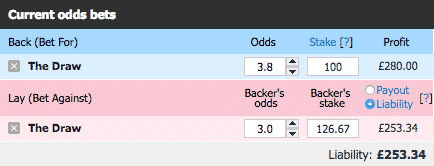Laying bets – strategy and systems
James McMath
3 Jan 2017
Updated: 19 Nov 2023
Lay betting is when you place a bet on something not to happen.
For example, instead of betting on (backing) Chelsea to win the Premier League, you lay Chelsea.
This means you would win your bet if anyone other than Chelsea wins the title.
Essentially, when you lay an outcome, you act like a bookmaker. You are betting against other users.
The emergence of betting exchanges such as Betfair and Smarkets have made lay betting more popular and helped change the way people gamble.
Exchanges have paved the way for cash-out options, an in-play markets, which almost every major sportsbook now offers.
Laying bets in matched betting
Lay betting is largely what makes matched betting possible, or at least, much easier.
Because matched betting relies on the punter placing bets on two opposite outcomes (a binary bet), one half of the bet will be a lay bet, most likely on an exchange.
Working out how much to stake on each half of the bet – how much to back and how much to lay – is the tricky bit.
And that’s where Profit Accumulator’s betting calculator comes in particularly useful.
Members can also access oddsmatching software, which will automatically flag up instances where they lay price is higher than the bookmaker price – an arbitrage bet opportunity.

Profit, liability and liquidity
The most important thing to understand about laying a bet is that the profit (amount you could win) and liability (how much you could lose) are different to a traditional bet.
Placing £10 on a 5/1 shot will win you a profit of £50. Straightforward.
In effect, the formula is reversed when it comes to laying.
To make a profit of £10, the layer would have to be willing to risk £50.
Liquidity is the amount of money available to back or lay in a given market.
This is because exchange betting is between users, rather than a bettor and bookmaker.


The amounts available will depend on how popular the markets are.
For example, the amounts available on a Premier League football match are likely to be higher than a minority sport.
When backing or laying, it is important to check there is enough liquidity in the market at the price you desire, otherwise some or all of your bet might not be ‘matched’.
If you are new to exchange betting, Betfair have a very useful beginners’ guide available as an ebook.
Betfair also has a ‘what if’ option, to allow you to test the outcomes of a bet and see whether your selection would return a profit or a loss.
Lay betting to guarantee a profit
A little like hedging, lay betting can be used to reduce risk and, in some cases, guarantee a profit.

A shift in circumstances and odds can present opportunity to lay a selection you have backed or vice versa.
For example, you back a football match to be a draw at odds of 3.8 with a stake of £100 – the potential profit is £280.
At half-time the game is still 0-0 and nothing much at happened, the odds of a draw will have shortened, say to 3.0.
If you chose to lay at this price to win £126.67, your liability would be £253.34.

If the match is a draw, you win £280 but lose £253.34 that you laid, meaning a £26.67 profit.
If the match is not a draw, you win £126.67, minus your £100 stake, also resulting in a profit of £26.66.
Decimal odds explained
Lay betting odds on exchanges are often displayed as decimals, rather than fractions favoured by most British bookmakers.
Decimal odds are used because they are more accurate than fractional odds and offer more transparency to the user.
If you are not used to dealing with decimal odds, they can look a little confusing.
One aspect of decimal odds to understand is that the backer’s stake is included. So odds of 2.00 are evens (1/1), with the stake counting as 1.00 and odds of 3.00 is 2/1.
To convert fractional odds to decimal, divide the first figure by the second figure and then add 1.00.
For example, 11/4 is 11 divided by four, which is 2.75, plus 1.00, equals 3.75.
To convert decimal odds to fractional, subtract 1.00 and convert to a fraction, reducing to the simplest form.
For example, 1.75-1 = 75/100 or 3/4.
